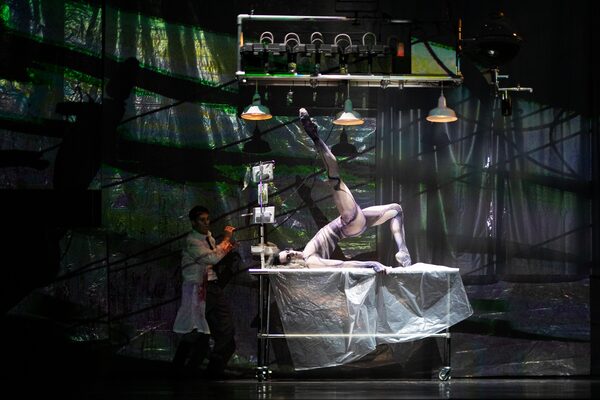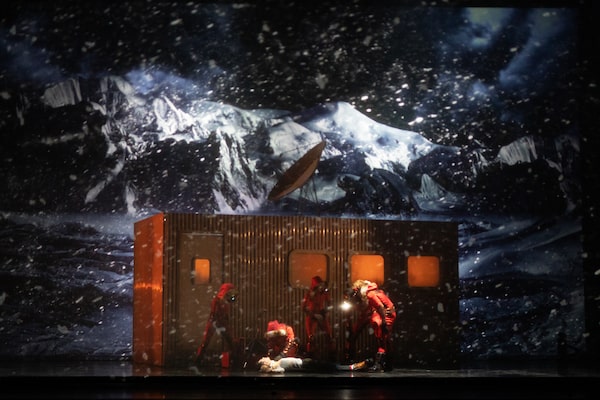
Zacharie Dun must be the most agile Frankenstein monster in history.Alberta Ballet
How do you choreograph English literature’s most memorable monster?
Alberta Ballet artistic director Jean Grand-Maître, taking his cue from Oscar-winning director Guillermo del Toro (The Shape of Water), has created a creature (danced by Zacharie Dun with six degrees of exhilaration) that is a sinewy, lizardy and amphibious kind of monster who, when he comes to life, is ignited through his legs.
In this highly-stylized, sleekly physical iteration (with imaginative costume design by Anne-Séguin Poirier), he’s a little bit Dr. Frank-N-Furter (Rocky Horror Picture Show) and a little bit Cirque du Soleil – and a lot of that monster who climbed out of the tub in The Shape of Water to accept his Oscar a couple years back.
He’s also the so-called “abandoned” offspring of Victor Frankenstein (Kelley McKinlay), a Harvard blue blood whose scientific reach exceeds his human grasp, leading to what are undoubtedly several of the most unlikely duets in dance history, when the monster and his maker go mano-a-monster.
Those are also the moments when Frankenstein is most fully realized, and truly ignites as a combination of dance, theatre and even opera (set designer Guillaume Lord has designed operas and several Cirque du Soleil shows).
The plot revolves around a wealthy Florida family with a seriously ill mother and a loving son who turns to science and lands at Harvard, hoping to find a way to bring the dead back to life.
Victor’s lab is draped with plastic sheets and splashed with blood as he messes with genetics, which the Alberta Ballet ensemble inject with a robust physicalization that blends classical dance with a workout video.
McKinlay here is almost manic as Dr. Victor Frankenstein, dancing in a lab coat and office wardrobe, turning the intellectual act of creation, with all of its fits and starts, fails and triumphs, into a kind of physical language of frustration.
At the top of Act II, Dr. Frankenstein and his monster confront one another against a backdrop of a full moon and stunning video-projected images (beautifully designed by Adam Larsen) of a body of water and the effect is palpable: In isolation, Grand-Maître and his A-Team of designers locate the emotional primary colours that elevate Frankenstein and – hey, why not – bring it to vivid, pulsating life.
That’s where Dun, who must be the most agile Frankenstein monster in history, parries with his creator, who has failed to provide him with a mate, a sticking point that provokes the monster to take revenge against his maker.
Dun’s movement blends a sense of menace with something else – a longing to be a little less of an outlier. He’s a monster who craves being a good neighbour, and Dun succeeds in physically articulating his sense of isolation.

Frankenstein feels like it is an homage to vintage classic Hollywood movies of the 1940s, and it is all too relevant to now.Alberta Ballet
The catch is that Frankenstein is a story ballet, with a lot of narrative points to hit, and that’s a challenging assignment for a choreographer – and audience – to have to plow through, in order to get to the next gorgeous, moonlit monster showdown.
That sizable chunk of the show involves Dr. Frankenstein and his BFF Clerval (Yoshiya Sakurai) flying back and forth between his family compound in Mar-a-Lago (it can’t be a coincidence) and Boston, and then, in the final scenes, a wintry Arctic compound that turns out to be Jasper, Alta.
Here, Frankenstein feels like an homage to vintage classic Hollywood movies of the 1940s, a feeling accentuated by Dr. Frankenstein’s appearance. McKinlay, a popular long-time Alberta Ballet company member, has the looks and demeanour of a 1940s American movie star, which Grand-Maître embraces through anachronistic wardrobe choices – there are smartphones, but also lots of fedora hats and herringbone overcoats – and design choices, such as a Google Map motif that recalls Raiders of the Lost Ark.
This Dr. Frankenstein is a 21st-century Clark Gable (and a little bit Paul Rudd).
The narrative is moved along by surtitles that flash above the stage, giving us plot and even glimpses of the voice of Mary Shelley, author of the original Frankenstein novel, and for the most part, it’s effective, even if you have to occasionally choose between reading and watching the dancers.
Frankenstein, the ballet, is equally propelled by a tremendous soundscape, designed by Claude Lemelin, who employs a song list that’s a blend of classical and postclassical composers to create an old-fashioned soundtrack that takes a deep dive into the effect technology has had on our human community.
All design spectacle aside, Frankenstein also comes boldly – and classically – to life during its ensemble numbers, such as in Frankenstein’s blood-drenched Harvard laboratory, or later, at the Mar-a-Lago wedding of Victor and Elizabeth (Mariko Kondo), particularly in a moving duet between the two that makes her violent demise a few scenes later resonate.
(Kondo’s duet with McKinlay also drives home the noticeable absence of feminine touches that permeates Frankenstein – it’s pretty testosterone-fuelled for ballet.)
Grand-Maître, in his program, notes reflects on del Toro’s comment that the crime perpetrated in the story is not the violence of the monster, but by Dr. Frankenstein, his maker – but here McKinlay’s leading man charm works against that theme.
In the climactic moments of Frankenstein, as Dr. Frankenstein faces off against his monstrous creation, who has wreaked more emotional havoc on his life than he could have imagined, it’s hard to remember who’s human and who’s the monster.
Frankenstein is a parable, adapted from a 19th-century scary story, told in physical language, set in an imagined world filled with pop-culture memories, about the unforeseen consequences of our infatuation with technology. It feels all too relevant to now.
Live your best. We have a daily Life & Arts newsletter, providing you with our latest stories on health, travel, food and culture. Sign up today.